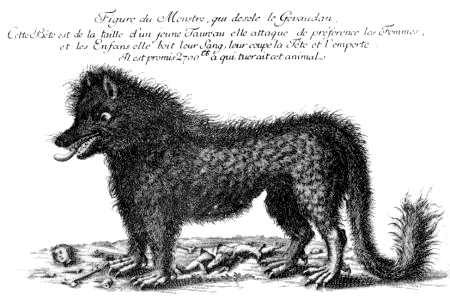
I loved this movie. It's the strangest sci fi kung fu movie ever made. The story is that a giant wolf is attacking villagers and the protagonist is sent to kill it. Well, really, you want to find out what it is. It's a scary movie and really really really cool. I was stumbling, and I came across this Wikipedia article. It was a real legend! Here's a summary:
The Beast of Gévaudan (French: La bête du Gévaudan) was a mysterious wolf-like creature that terrorised the former province of Gévaudan (modern day Lozère département), in the Margeride Mountains in south-central France from about 1764 to 1767. Many attacks took place - between 60 and 123 humans were killed – and debate continues as to the Beast's true identity. The story is a popular subject for cryptozoologists and conspiracy theorists.
The first attack that provided a description of the creature took place on 1st June of 1764. A woman from Langogne saw a large, lupine animal emerge from the trees and charge directly toward her, but it was driven away by the farm's bulls.
On the 30th of June the first official victim of the Beast was Jeanne Boulet, killed near the village of Les Hubacs, not far from Langogne.
The creature's reported method of killing was unusual for a predator, often targeting the head, and ignoring the usual areas targeted by predators, including the legs and throat. Often the head was crushed or removed. It also seemed to target people over farm animals, reportedly having an aversion to cattle; many times it would attack someone while cattle were in the same field.
There were some reports that the beast was seen with another such animal, or with young. No recorded testimony implies the presence of a man nearby.
Though it is difficult to establish an exact number of victims, an estimate based on official documents gives over 198 attacks, including 36 wounded and 88 dead. Other sources could expand these results to over 306 attacks, including 51 wounded and 123 dead. The Beast's preference towards women and children is perhaps due to their working the country-side farms in pairs or even alone, making themselves easier targets. Men, however, tended to have objects that could be used as weapons, such as sickles and scythes, and often worked the fields in large groups.
Various explanations were offered at the time of the attacks. They ranged from exaggerated accounts of wolf attacks, to a loup-garou (werewolf) all the way to the beast being a punishment from God, or perhaps an unholy creature summoned by a sorcerer.
Though wolves in the wild usually avoid contact with humans, they will attack livestock when their natural prey runs out. Conversely, the Beast itself was said to have taken exclusively human victims, ignoring the livestock present in the area. Some experts, however, state that wolves at the time may have been more aggressive than their modern-day counterparts, saying that today's generation of shy wolves is the result of natural selection favouring animals which were less prone to attacking humans with firearms. The areas in the world today where wolf attacks are still a common occurrence are usually poverty-stricken with a general lack of predator control technology.
Other theories say the beast may have been an escaped captive exotic animal such as a hyena. Two species have been known to attack humans: the striped hyena of Africa, the Middle East, Pakistan and western India and the larger spotted hyena of Africa. Hyenas are known to inflict injuries similar to the Beast of Gevaudan, primarily biting the facial regions when attacking humans; however hyenas do not have the smooth running gait ascribed to the Beast, and are not good at jumping. According to Loren Coleman's Cryptozoology A to Z, page 35, a taxidermist at the National Museum of Natural History in Paris, Franz Jullien by name, discovered that an animal similar to the description and listed as shot by Jean Chastel, had been stuffed and was on display from 1766 to 1819. It had been definitely identified as an African striped hyena.
Another explanation is that the beast was some form of domestic dog or hybrid. This theory has found support from, among many others, naturalist Michel Louis, author of the book La bête du Gévaudan: L'innocence des loups (The Beast of Gévaudan: The innocence of wolves). The beast may have been a wolfdog, according to the TV show Animal X . Wolf-dog hybrids were usually noted as not sharing their wolf parent's fear of man and it would have also been quite trainable, perhaps lending further credence to the reports that the Beast was seen in the company of a human.
Some have suggested that a male lion imported from Africa was responsible, and this was the explanation used in the film Brotherhood of the Wolf. Proponents of this theory have noted how there are similarities between a male lion and contemporary drawings of the beast. Critics have argued that the local people would have recognized and identified a lion, due to the fact that lions had appeared on various coat of arms at the time.
I think it's really interesting.








